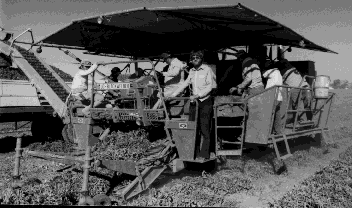
The harvester manufacturer (in Rio Vista, CA) needed an automatic way of controlling the sickle height respect to the ground as the harvester moved down the tomato field. I designed the entire servo loop to keep the sickle a constant distance below or above ground level, as specified by a dial set by the operator.
I obtained a patent (Patent #4414792 granted 11/15/83) for the position servo loop using an ultrasonic sensor to measure distance between ground and frame. The distance from sickle to frame is measured by an LVDT. An operator sets a potentiometer for the desired distance. The distance the sickle is below or above ground is what needs to be controlled, and this is calculated using analog circuitry.

[Enlarge, colorize and describe]
The ultrasonic sensor is calibrated for variation of velocity of sound in air. There is a narrow bar in front of the ultrasonic transducer giving an echo a short known distance away. This echo is used with a phase locked loop. The echo is translated to a pulse and goes to one input of the phase detector, the other input being from a pulse generated by a certain count of a counter that is reset upon transmit. The output of the phase detector contains the servo "error" signal, and is compensated and fed to the VCO. This VCO clocks the counter. Therefore, the counts are always calibrated with distance, and independent with time. The counter is stored into a register when the echo from the target is received, then converted to analog using a DAC.
There are no electric motors in the control system, as the system is hydraulic (oil). Motions are linear (as opposed to rotary) by use of hydraulic cylinders. A solenoid-valve controls oil movement into the cylinder, one for each direction. There was an option of using on-off valves or linear valves (which are used in airplanes). I selected the on-off valve because it was 1/10 the cost, saving over $800 per machine. This would have resulted in an unstable control system but for my method of controlling the valve. I used off-pulse width modulation (a VCO followed by a retriggerable timer) to modulate the valve. This was calibrated to pulse the sickle position in increments of 1/10 inch. Following feedback control system theory, the rate of pulsing, and therefore the hydraulic fluid flow rate through the valve, was proportional to the "error signal" and compensation network combination. The hydraulic cylinder integrated (mathematically) the hydraulic fluid flow resulting in position control.
There were two position control loops (but only one bidirectional valve to drive the motion). The inner loop one used an LVDT for position feedback and kept sickle distance constant respect to average ground distance, and had higher gain then the outer loop. The outer loop used the ultrasonic sensor and was an averaged (low pass filtered), low gain loop that determined the ground distance respect to body frame. The desired result was that
Also necessary was proper compensation of the system, a lead-lag network. Without this compensation, the sickle would oscillate up-down, as predicted by the theory.
I designed an over-damped system, to eliminate any overshoot. An overshoot in the downward direction caused the sickle to scoop some dirt out of the ground, and when the sensor (ultrasonic) measured the ground distance, it caused the sickle to drop. This was a positive feedback, an instability, that had to be eliminated, because the machine would dig itself into the ground. This was achieved by eliminating overshoot and by locating the feedback (the ultrasonic sensor) as close as possible to the sickle itself, to reduce the time delay, as the harvester went forward, between dirt height at the sickle (the ideal location point for the measurement), and the actual location point for the measurement, about two feet behind the sickle due to mechanical space constraints.